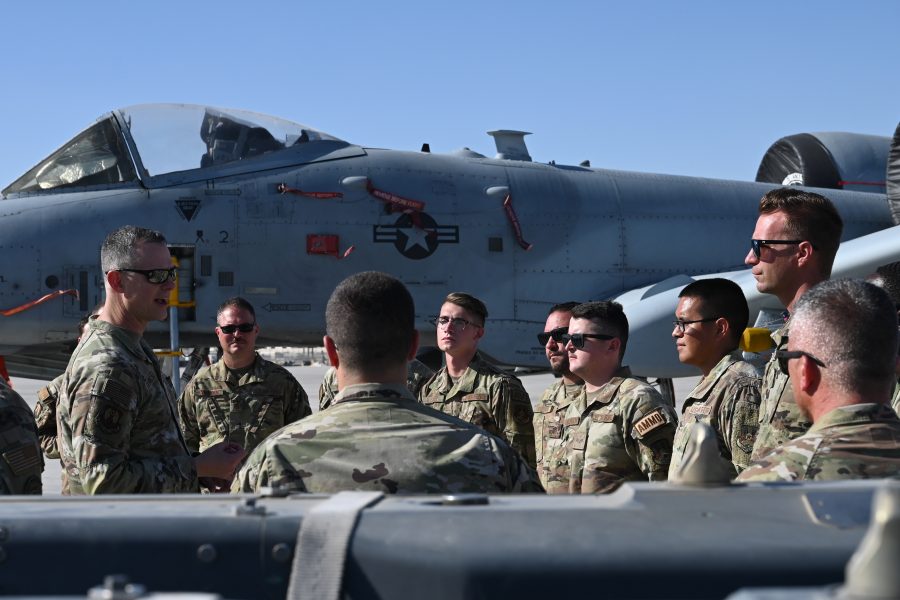The sweeping changes the Air Force is proposing as part of its re-optimization initiative are intended to strengthen the Pentagon’s ability to deal with China’s growing military might.
But they have important implications for American military posture in the Middle East as well, according to the top Air Force commander for the Middle East.
A top example is the shift to a new deployment model in which larger teams of Airmen—with different specialities and possibly even operating multiple aircraft types—will train and deploy together in “units of action,” either as an entire combat wing or as a force element.
“Those deployable combat wings will be extremely useful in any theater as well if you have these intact teams that are able to go and open a base and operate a base and command airpower,” Air Forces Central (AFCENT) commander Lt. Gen. Alexus G. Grynkewich told reporters at a Defense Writers Group event April 3. “It’s just going to be a much more coherent capability for us, just like it will be for the Indo-Pacific.”
AFCENT is moving towards the new model as the U.S. seeks to deter Iran and use airpower against the Islamic State group, Iran-backed militias in Iraq and Syria, and the Houthis in Yemen. Doing so, however, is not without challenges, including when it comes to nurturing relationships with partners in the region.
Some of the key bases AFCENT has relied on in the region for decades, such as the massive Al Udeid Air Base in Qatar—AFCENT’s forward headquarters—and Prince Sultan Air Base in Saudi Arabia are commanded by one-star U.S. Air Force generals. Operating from these locations can be a delicate political balancing act, which AFCENT officials say is enhanced by relationships commanders build with their counterparts.
Yet the new deployment model will shorten the tours for some commanders, Grynkewich noted, with some rotations going from one year to six months.
“In some cases, we have leadership teams that were in place for a year that will go to six-month rotations,” Grynkewich said. “That will be something that we have to work on and double down on our investment in partnerships.”
Grynkewich, who is due to depart AFCENT later this month after nearly two years to become director of operations for the Joint Staff, said one way to keep ties strong might be to tweak the model so there are longer deployments for some critical headquarters staff.
“We’re looking at how do we supplement the rotational forces with some key positions that will be more sustained over time,” he said. Grynkewich said such positions could be at the Combined Air Operations Center at Al Udeid or involve host nation coordination at some significant bases, though the end state—like all of the Air Force’s re-optimization changes—is not yet fully defined.
One aspect of the Air Force’s re-optimization is particularly encouraging, he said: the Air Force’s push to more coherently develop new technology.
“One layer at the higher strategic level is trying to break down the stovepipes and build integrated capabilities as opposed to the combat air forces building a capability and mobility air forces building another one,” he said.
In 2016, the Air Force released an “Air Superiority 2030 Flight Plan” that argued for a more comprehensive approach to technology development and which was co-authored by then-Col. Grynkewich.
“The main takeaway of that is you really needed kind of an integrated, holistic approach to fielding capabilities,” Grynkewich said of the study. “If your fighter was going to have a certain range, then you needed a tanker that could go certain places to extend that range. If the fighter range was shorter you needed a tanker that could go farther, just as a simple example.”
That is something the Air Force is trying to achieve through the new Integrated Capabilities Command and other efforts.
“I think that is just going to help warfighting capability be developed more holistically in the future,” Grynkewich said. “That’ll be a benefit, no matter where the conflict is. So even though it’s optimized for China … we’re pretty bad at predicting where we’re going to have a conflict. If we end up fighting somewhere else in the world, whether it’s the Middle East or elsewhere, I think it’ll have a benefit.”


